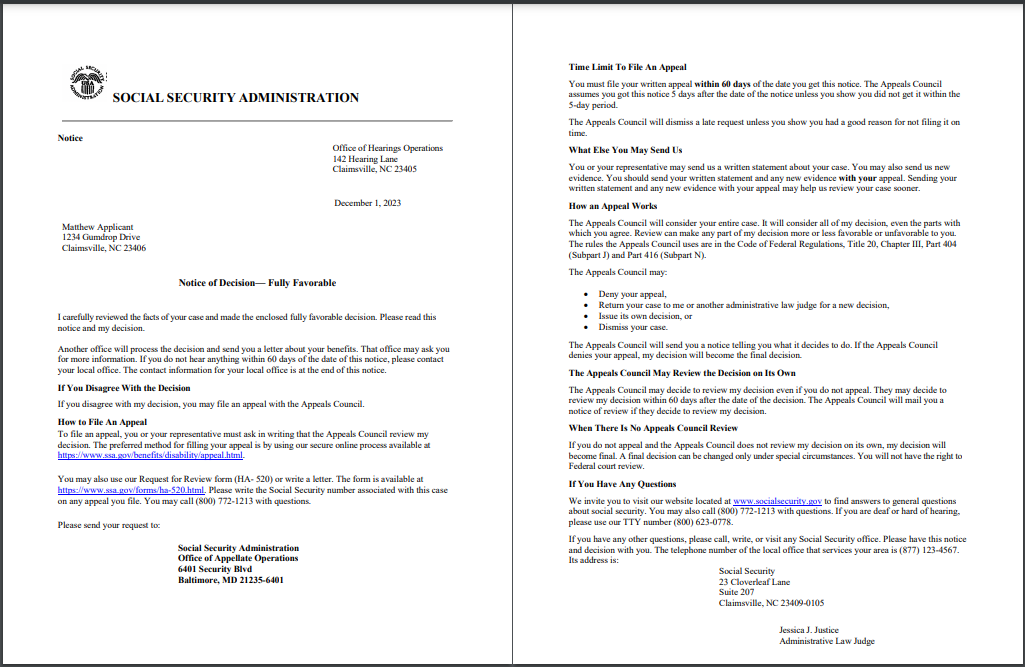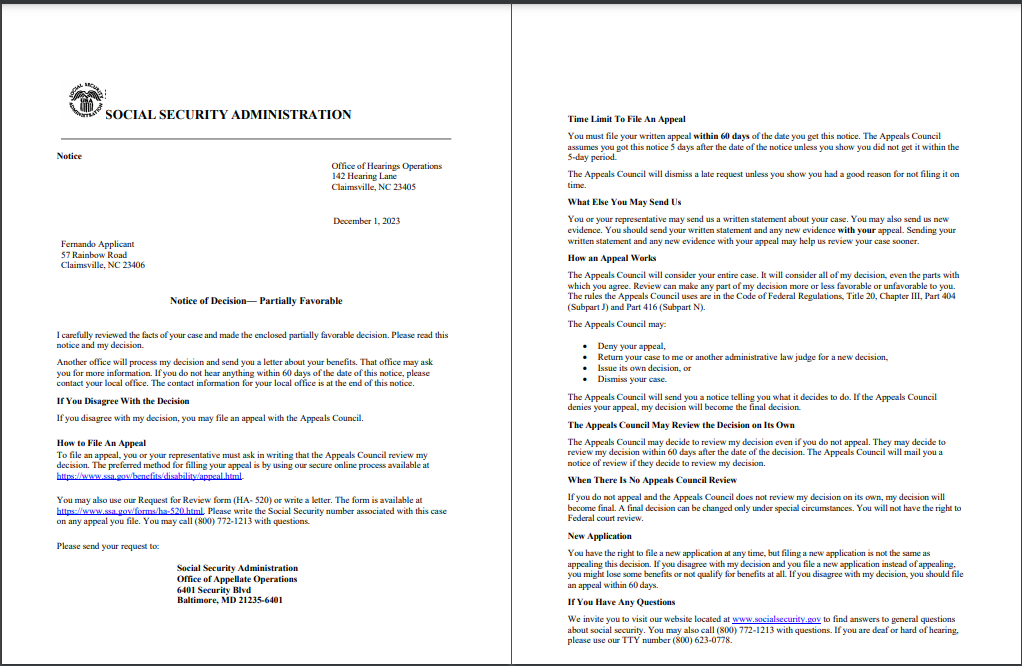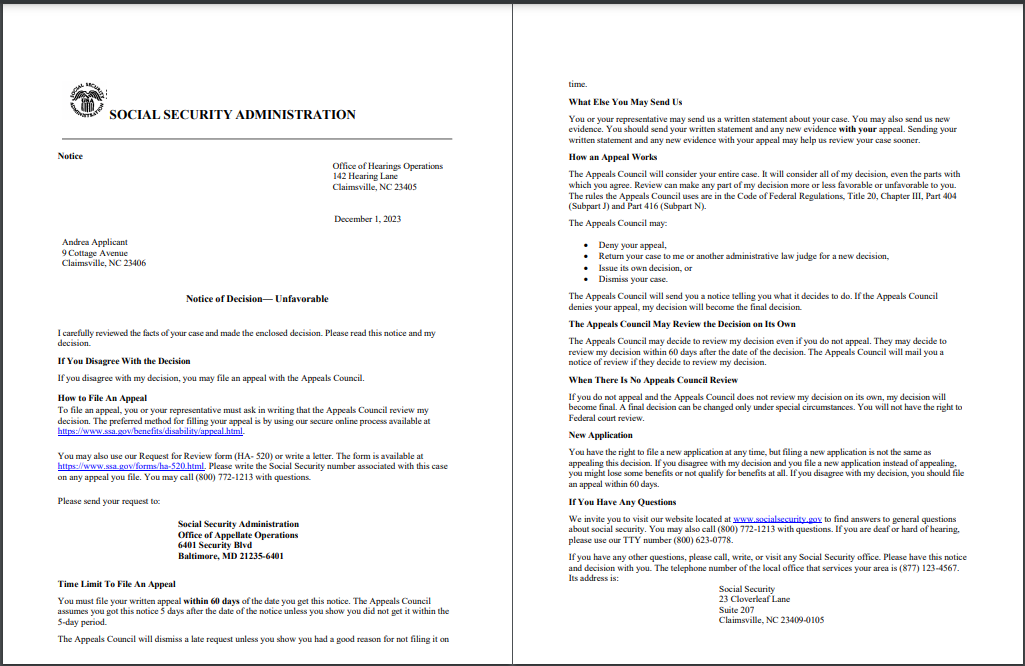Learn about the possible decisions the administrative law judge (ALJ) may make after a Social Security Disability hearing.
Most disability applicants who attend a hearing in front of an administrative law judge (ALJ) don't find out if they've won their case that same day. After a hearing, the ALJ will send a written decision to you in the mail. The decision states whether you were approved or denied for benefits, and includes a discussion of the process the ALJ used to make the decision.
Types of ALJ Decisions
ALJs have three types of decisions they can issue: fully favorable, partially favorable, or unfavorable. Decision letters begin with a notice letting you know what the judge's ruling is, as well as information about the next steps. An in-depth analysis of the judge's findings, called the decision rationale, should be enclosed with the notice.
Full Favorable Decision
A fully favorable decision means that the ALJ thinks that you're disabled, and agrees with you about the date your disability began. Here's an example of a fully favorable decision notice (click to enlarge):
 Partially Favorable Decision
Partially Favorable Decision
A partially favorable decision means that the ALJ thinks that you're disabled or have been disabled at some point, but disagrees with you about the dates of your disability. Here's an example of a partially favorable decision notice (click to enlarge):
 While both types of favorable decisions entitle you to ongoing monthly disability benefits, partially favorable decisions can cut into any backpay you could be owed.
While both types of favorable decisions entitle you to ongoing monthly disability benefits, partially favorable decisions can cut into any backpay you could be owed.
Backpay is based on your established onset date (the date that the ALJ thinks you became disabled). Partially favorable decisions happen when your established onset date is different from your alleged onset date—the date that you think you became disabled.
Unfavorable Decision
An unfavorable decision means that the ALJ doesn't think you've been disabled at any point during the time period your application covers. Here's an example of an unfavorable decision notice (click to enlarge):
Understanding the ALJ's Discussion of Your Hearing Decision
Regardless of whether you received an approval or a denial, the judge is required to explain the decision to you in a written opinion. The opinion addresses each step of the sequential evaluation process that ALJs use to determine whether somebody is disabled, and applies to the facts of your case at each step.
Step One: When and If You Stopped Working or Doing SGA
The first step of the analysis is the most straightforward: you can't be found disabled if you're earning at or above the level of substantial gainful activity (SGA). In 2024, the SGA threshold is $1,550 per month. If you're earning more than that, the ALJ can't award you benefits, unless the judge determines that your earnings are the result of an unsuccessful work attempt. If the judge finds that you're not working above SGA, the opinion will proceed to a discussion of step two.
Step Two: Why Your Impairments Are or Aren't "Severe"
In step two, the ALJ discusses whether your impairments are "severe" according to Social Security's definition. Severe impairments are medical illnesses or conditions that have significantly restricted your activities of daily living for at least one year.
If you don't have any severe impairments, the ALJ will deny your claim. Many people have a combination of severe and non-severe impairments. The ALJ must discuss each condition and explain why it is or isn't severe. As long as the ALJ determines that you have at least one severe impairment, the opinion will proceed to discuss the third step of the analysis.
Step Three: Why Your Impairment Does or Doesn't Meet a Disability Listing
In step three, the written opinion will discuss whether your impairment meets or equals one of the medical conditions (called listings) that qualify for automatic approval. If your condition does meet or equal a disability listing, the ALJ will explain why you meet the listing criteria, with reference to specific evidence in your medical record. If you don't, the ALJ will discuss why not, in detail, and continue to step four of the analysis.
Step Four: Why You Can or Can't Do Your Prior Work
During this step, the judge will discuss the jobs you performed in the past 15 years. The ALJ will classify your past work according to how physically demanding the work was (called the "exertional level") and how mentally challenging the work was (the "skill level").
You'll see a set of numbers known as the DOT code corresponding to a Department of Labor description of the jobs you've performed.
The ALJ will then discuss whether you can do any of your past work by comparing the exertional and skill level of those jobs with your current residual functional capacity (RFC). Your RFC is the most you're capable of doing in a work setting.
If a vocational expert testified during your hearing that you can still do your old job, or if the ALJ felt you could still perform your past work, the opinion will explain why, and you will be denied. But if the ALJ doesn't think you could do your past work, the opinion will continue to the final step.
Step Five: Why You Can or Can't Do Other Work
The last step of the analysis is the usually most detailed portion of the opinion. The ALJ will discuss your medically documented symptoms, review any statements from your treating doctors or consultative examiners, refer to lab tests and imaging results, and address your hearing testimony.
The ALJ will consider any inconsistencies in your records or your testimony, and explain how and why they can be reconciled (in a favorable decision) or not (in an unfavorable decision). Judges often use this step to discuss whether the evidence supports a decision that you're as physically or mentally limited as you described at the hearing.
Finally, the ALJ looks at your age, education, and whether you acquired any skills from your past work to see if the medical-vocational grid rules say that you're disabled.
When the grid rules don't apply, the ALJ will usually determine whether you're disabled based on the questions the judge asked the vocational expert at your hearing. If the ALJ agrees that your limitations prevent you from doing any work, the judge will award you benefits.
Updated December 12, 2023
Talk to a Disability Lawyer
Need a lawyer? Start here.
How it Works
- Briefly tell us about your case
- Provide your contact information
- Choose attorneys to contact you
Get the Compensation You Deserve
Our experts have helped thousands like you get cash benefits.
How It Works
- Briefly tell us about your case
- Provide your contact information
- Choose attorneys to contact you
